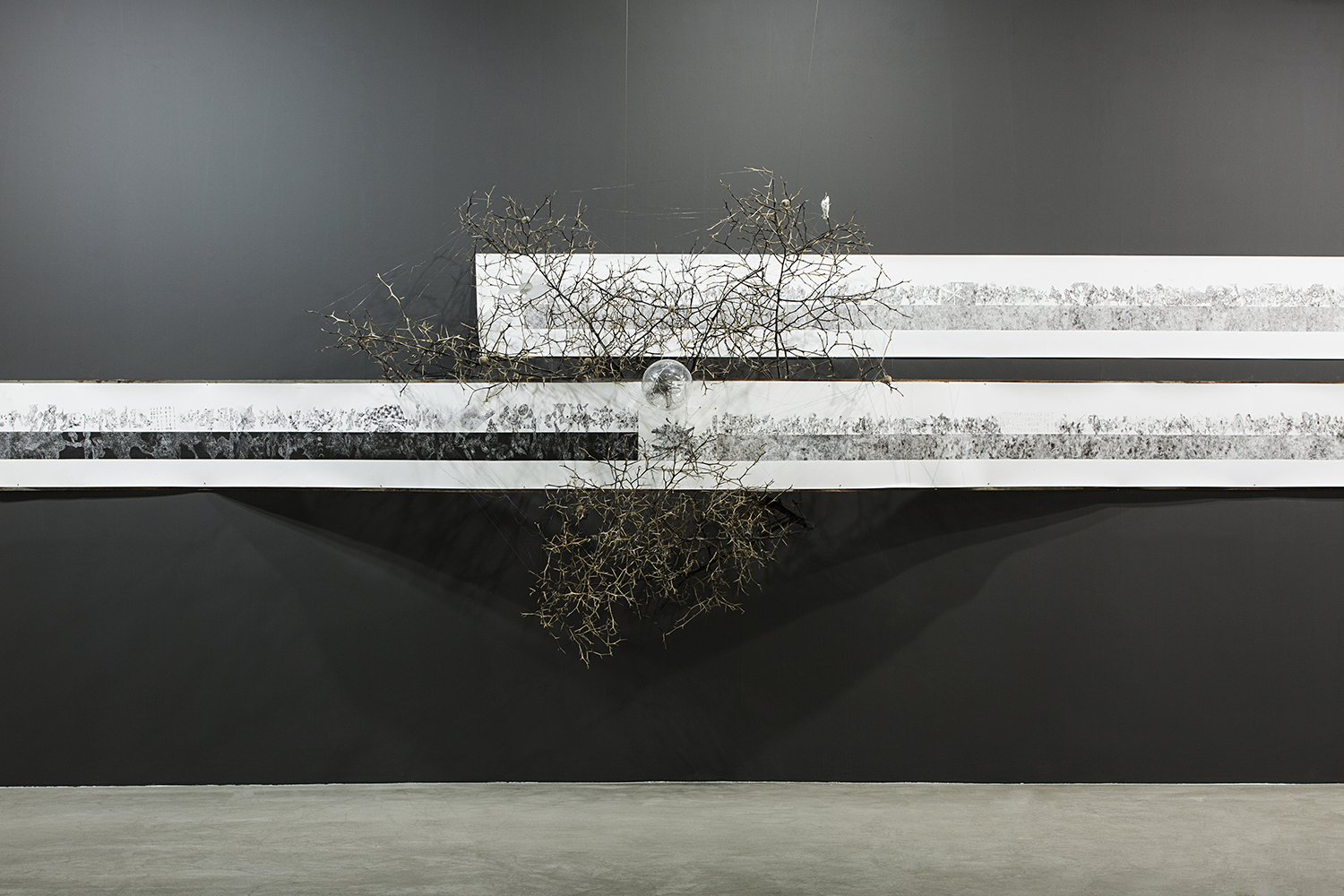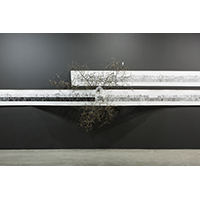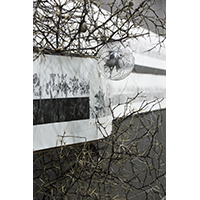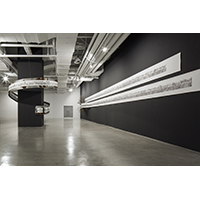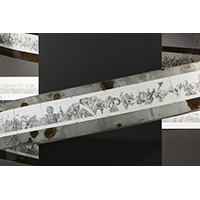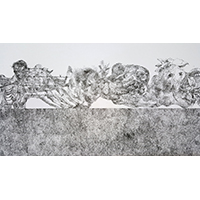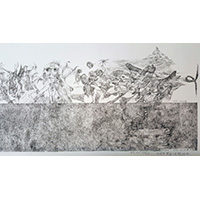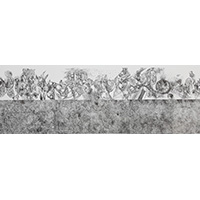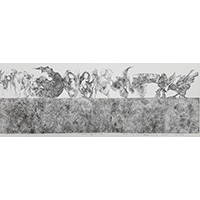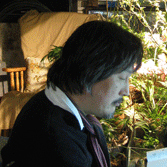
Seunghwan Ryu, OCI Museum of Art
Birth
1961, Seoul, South Korea
Genre
Painting, Installation
Homepage
Art that Questions the Duration
Toward the Art Inhabitable in the Duration_
While researching artists for developing the theme of the exhibition, suddenly the artist note of Seunghwan Ryu caught my eyes. In the note he wrote
“… daily life and information, understanding and discovery of the life as recording and the contents of the three entries of time, space and humans are appeared as changes and trends in my work. Entries of time, space, humans appear to changes and trends. My work represents obtained images (that both visible and invisible) from where I stay and the continuity of time the obtainment process proceeds. Figure is the living archive of creation by my hands and organically relating with various surrounding condition and prepares for a firm platform for a new world.”
Seunghwan Ryu’s work is flexible but also tenacious enough as felt nervous. Since 1991, he has recorded the images coming to mind through everyday ordinary experience such as reading book or reflection of life, on the letter sized papers as writing a diary. Motif of his drawings are variety as including ancient cultures, microorganisms, language, mathematics and geometry, propagation, and the theory of relativity. And with the slow but continuous process of drawing a few centimeters of each day has been filling about 500-meter-long paper. His artist notes and the drawings is a crucial role to decide the subject of the exhibition as ‘duration’.
However, it does not mean that other five artists not related to the theme. But, definitely, Ryu’s drawings are corresponding to the work of Roman Opalka that constantly records the process of writing down numbers and reading aloud it every day. More than Opalka’s work merely recording numbers, Ryu’s work has flow of narration and the root are in contact with death. As you can see in his work a reflection about life and death is the way to meet consideration on duration.
Taeman Choi
Epos: a peristalsis of time and text
Time
is ever-flowing, and it demonstrates the mutability of all objects and beings
in the universe. Since the beginning of civilization, humankind has developed
the habit of recording the flow of time, using various symbols and languages.
In this sense, the text, whether in the form of ancient Egyptian hieroglyphics
or the Greek alphabet, is a manmade instrument, but at the same time it serves
a greater purpose as a vessel of time itself. Nevertheless, the fundamental
character of the text is not the same as that which is found in nature. The
timeline formed in nature is an embodiment of every moment and every second,
represented without guile or prejudice. The text, on the other hand, only seems
as though it is representative of every single event, when in truth it is derived
from the biased perspective of an individual. In short, while nature is a
completely objective chronicler of its daily comings and goings, the text is
the projection of a series of subjective observations made by man. Nevertheless,
history, a genre of text, is written under the ‘who, what, when, where, why,
and how’ rule (Five W’s and One H rule) to maximize objectivity and minimize
subjectivity. However, in contrast to the epos, history is an imperfect
narrator of time. The epos is able to reflect even the unseen constituents of a
certain context or situation, allowing it to elaborate its contents with much
more ease compared to history; history is often an incomplete puzzle, with
several pieces missing in the picture, whereas the epos is a song of time, with
every note accounted for. Held within the changes of human society are the
lives of individual people, which in turn are ruled by fate. Thus, the epos,
which records such constant and often tumultuous changes in time, may be the
greatest gift and the greatest curse that mankind has been endowed with.
Ryu’s works can be characterized as
‘epic’ in many different ways. Yet, his uniqueness is not represented by the
content of his works, but in his method of creating them. Since 1990, Ryu has
taken refuge in his small studio in Samsungdong, recording every bit of
information, knowledge, and experience he has encountered. Within the studio is
a table, at which Ryu’s works are birthed. This table is occupied by books of
philosophy, history, and antique scriptures. It is an altar of knowledge, one
which can be likened to that used by an ascetic monk; a microcosm constituted
by comprehension and experience. At this table Ryu has been traveling to the
world of wisdom, utilizing the elements of time, space, and humankind as
coordinates to guide him to it. His thoughts and vast amounts of information,
attained from numerous books and experiences he has come across over the years,
are reborn as the cartography of his epos, and he realizes the map upon a roll
of paper.
The epos that Ryu creates is
strictly in the form of drawings. Therefore, the various graphic effects seen
in other types of art are excluded. His only tools in configuring his works are
pens with 3mm tips, most of them being standard black in color. This system
allows his drawing process to take on the form of a more basic and somewhat clerical
procedure, making Ryu’s work more like that of a historiographer than an
artist. Also, his usage of the roll of paper is another feature that presents
an oddity that separates his drawings from those of others, and at the same
time maximizes their epic facets. Before the moment of creation, Ryu prepares a
30cm-long roll of paper, cut from a much larger sheet. This is a feat – he
confesses – that requires half of his day. In the modern world, where the unit
of documents and other literary works has been conformed to the page (as
opposed to the roll), the concept of a continuous and connected form of records
is not easy to grasp. The difficulty arises from the disparate nature of the two
different units; the separated pages of modern books, contrasted by the
unbroken contents of the lengthy roll of paper. Ryu has taken on this method,
which deviates from the old notion of the drawing (a depiction of a singular
image in a strictly separated screen), and by doing so he has moved forward
with the world; just a few years back, we “flipped through” comic books, but
now we are able to “scroll down” comic strips on the web, and the latter is
much more effective in showing the continuance of time and the correlation of
events – an important aspect of an epos. As Ryu’s pen tip glides across the map
of his epos upon the 30cm of paper, he leaves a third of the space for the
other part of his works. Unlike other artists, who only inscribe the date of
completion, Ryu goes the extra mile by recording not only the beginning and the
end, but all the events in between; the amount of time it took, the days of
rest, and even the days when he failed to draw the intended amount are all
recorded. This honest communication (the most crucial component of a true epos)
with the audience of his works not only shows the enthusiasm and worries during
creation, but also serves as a disclosure of his private life, making the work
itself the very proof of Ryu’s existence: pingo ergo sum.
After preparing for his labor, Ryu
adds on the contents of the epos – the drawing – which deal with “life,
language, silence, myth, and the world of the future,” as put by the artist
himself. Every so often a direct criticism of society and his own political
opinions are also amalgamated with the principal topics. However, one cannot
specifically dictate the substance of the completed piece. This perplexity is
due to the fact that the images are, for the most part, merged in a very
intricate and complex manner, and the borders between each scene are nonexistent.
It is in this quality that the peristalsis of Ryu’s text is shown with utmost
lucidity. It can also be said that the morphing and organic trait of his illustrations
is a major trait of his works. The idea he wants to point out through the convolution
of images are super-metaphorical or meta-symbolical. Still, it is not a
completely inconceivable encryption. As the mechanism of people being able to
understand foreign languages through impulse and feelings, Ryu’s creations
become harder to comprehend as the viewer becomes more aware of the
institutionalized syntax of the image as they know it. In reality, it is when
the viewer recovers a more basic sensitivity that the drawings elucidate the
epos of the artist who created them. But of course, the number of viewers who
will be able to rise to such a status is expected to be low.
Whatever the artist himself says
does not seem very important, for, unlike history, the epos does not need to be
an exact witness of time. For that reason, Ryu’s hieroglyphics do not seem to
have the rules and regulations as other codes do. Instead, they seem to have
fruited through the arbitrary cross-pollination of his artistic sensitivity and
the epic cause of his works. The element of chaos within this phenomenon could
represent artistic liberty, but could also signify the protection of the
interpretation of the audience; a reflection of the artist’s intention to suggest
the audience to break free from the norm of the image, and freely create their
own visual epos. Ultimately, Ryu’s works seem determined to make a connection
between its audiences; a connection like the one made when two different
children are able to have a carefree conversation in their two different
languages.
Jung Rak Kim
Description of documented works
My work is inspired by daily life. The
inherent changes within ordinary elements, such as media, television, books,
music and current events are the impetus for my work. Through knowledge and
discoveries, human beings realize intangible, universal truths. These
statements come to me in microscopic or spatial means. My thoughts, hands and
eyes are unified by energy and creation, like a grape that grows bit by bit in
order to sustain the next cycle of fruit. Life is as twisted as grape vines,
and can go any which way at the slightest whim. This exhibits the Chaos theory,
which is the most common motif in my work. The subtleties and rhythms of
geometry and the intrinsic possibilities of energy, holograms, technology,
lasers, simulations, ancient civilizations, and microbiology exist in my art.
There are three themes that are omnipresent in my work:
time, space and humanity. The most prevalent theme is humanity, especially
honor, silence, myth, the future and the subconscious. My images show that
elements of the human existence, such as perspective, distance, and location
are neither consecutive, nor ordered.
Elements of poetry, philosophy and science are imbued with
divine truths, and as we move into the twenty first century, they increasingly
intertwine to create an organic whole. These elements must be in dialogue with
one another, and individuals eventually realize that all elements of life are
interdependent. Everything comes from one source, and ultimately aspires to the
same goal.
My work transcends the five senses and the physicality of
the human body, through the conscious and subconscious mind. One of the
inexplicably basic mantras of life is that intangible truths exist without
rhyme or reason. Just because you cannot see something, does not mean that it
does not exist. I feel these truths in the vision that appears behind closed
eyelids, and in the muffled sounds that come through deaf ears.
These questions are constant in my life, and intrinsic to my
work. These ideas are amorphous, and can be sensed if you are attuned to the
patterns of the universe. I am seeking these truths in my thoughts,
and I am listening inside the chaos. The sounds are teaching me through the
time, effort and consciousness to feel these energies.
Seunghwan Ryu






